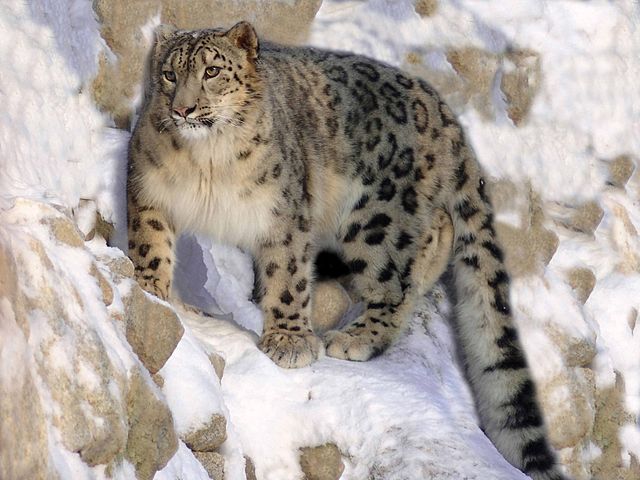The Darma valley in Uttarakhand's Pithoragarh district has recorded the first sighting of a snow leopard at an altitude of approximately 11,120 feet, highlighting the rare occurrence.
Snow Leopard: The Endangered and Elusive Big Cat
Snow leopards are one of the most elusive and endangered big cats in the world. These majestic creatures are found in the mountainous regions of central and south Asia, including countries such as India, Nepal, Bhutan, Pakistan, and China. Due to their shy and elusive nature, snow leopards are rarely seen in the wild, making them a mysterious and intriguing creature to study and learn about.
Snow leopards are known for their stunning beauty and unique physical features. Their soft, thick fur is covered with black spots and rosettes, which helps them blend in with their rocky mountainous habitat. Their long tails help them maintain balance while navigating steep terrain, and their large paws are equipped with fur on the bottom to provide traction on slippery surfaces.
Despite their stunning appearance, snow leopards face a number of threats in the wild. Habitat loss, poaching, and climate change are all contributing factors to their endangered status. Snow Leopard is listed as "Endangered" on the IUCN Red List, which means that the species is at high risk of extinction in the wild. It is estimated that there are only 4,000-6,500 snow leopards left in the wild.
The snow leopard is also listed in CITES Appendix I.
Conservation efforts are being made to protect the snow leopard and their habitat. The Snow Leopard Trust, for example, works with local communities in the snow leopard's range to implement conservation programs that benefit both the big cats and the people who share their habitat.
Status of Snow leopards in India:
India is one of the twelve range countries that host this elusive feline. Snow Leopard is an important indicator of the ecological health of the Himalayan region and the Tibetan Plateau. Snow leopards help in controlling the populations of prey species such as ibex and blue sheep making their conservation even more important.
Habitat and Distribution in India:
Snow Leopard inhabits the high-altitude regions of the Himalayan and Tibetan Plateau, where the average elevation ranges from 3,000 to 5,500 meters. In India, Snow Leopard is found in the states of Jammu and Kashmir, Himachal Pradesh, Uttarakhand, Sikkim, and Arunachal Pradesh. The estimated Snow Leopard population in India is around 400-700 individuals, which represents about 10% of the global population.
Snow leopards inhabit the following protected areas in India: Hemis National Park, Kishtwar National Park, Dachigam National Park, Gulmarg Wildlife Sanctuary, Hirpora Wildlife Sanctuary, Rangdum Wildlife Reserve, Overa-Aru, Kanji, Gya-Miru and Baltal-Thajwas Wildlife Sanctuaries in Ladakh, Jammu and Kashmir; Pin Valley National Park, Great Himalayan National Park, Rupi-Bhaba Wildlife Sanctuary, Sechu Tuan Nala Wildlife Sanctuary and Kibber Wildlife Sanctuary in Himachal Pradesh; Nanda Devi National Park, Gangotri National Park and Valley of Flowers National Park in Uttarakhand; Khangchendzonga National Park and Dibang Wildlife Sanctuary in the Eastern Himalayas.
Conservation Status in India:
In India, Snow Leopard is protected under the Wildlife Protection Act of 1972, and it is classified as a Schedule I species. The Indian government has also launched the Project Snow Leopard in 2009 to conserve and protect the Snow Leopard population and its habitat.
Challenges for survival in India:
The survival of Snow Leopard in India is threatened by various human-made factors. Habitat loss and fragmentation due to mining, hydropower projects, and infrastructure development have reduced the available space for the species to thrive. Poaching, for the illegal trade of Snow Leopard skin and body parts, is another major threat to the survival of the species. Climate change, which is causing the melting of the snow and ice in the high-altitude regions, is also affecting the prey base of the Snow Leopard, leading to food scarcity. Greenhouse gas emissions will likely cause a shift of the treeline in the Himalayas and a shrinking of the alpine zone, which may reduce snow leopard habitat by 30%.
Between 2003 and 2016, 710 skins were traded, of which 288 skins were confiscated. In China, 103 to 236 animals are poached every year, in Mongolia between 34 and 53, in Pakistan between 23 and 53, in India from 21 to 45, and in Tajikistan from 20 to 25.


